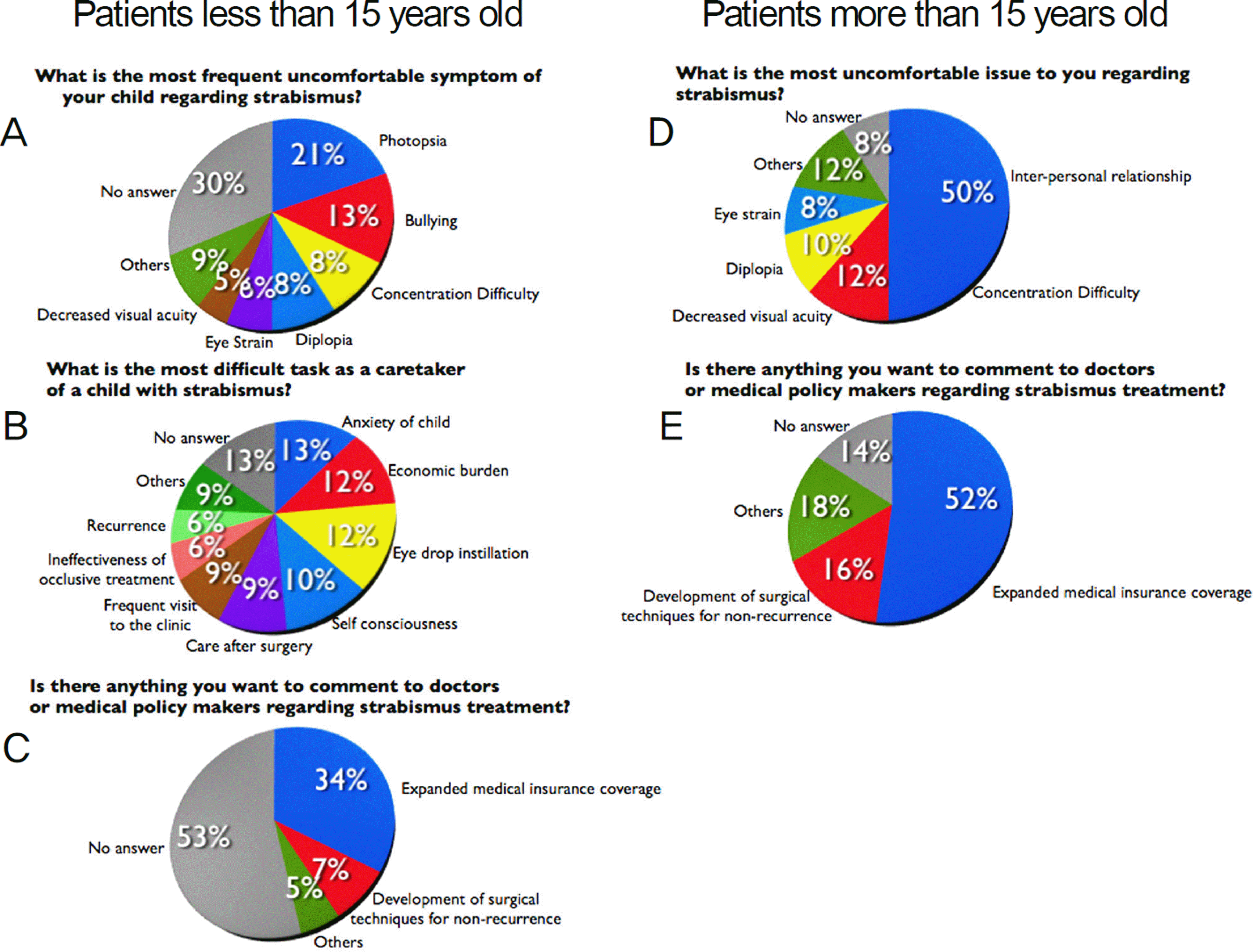Abstract
Purpose
To assess the effect of strabismus surgery on the quality of life by performing a quality of life-related health survey.
Methods
This study was comprised of 213 patients (163 patients under 15 years of age, and 50 patients over 15 years of age). After strabismus surgery, patients were asked to complete a standardized confidential questionnaire which eval-uated the quality of life and specific concerns related to the surgery.
Results
There was a significant change in the quality of life after strabismus surgery in both groups. No patient reported decreased quality of life after the surgery. Significant score improvement related to the questions designed to evaluate vision, stereopsis, diplopia and social relation was observed (p < 0.05). The number of surgeries did not affect the quality of life postoperatively. Multivariate regression analysis showed that change in the quality of life had significant correlation with social relationships (in both groups) and income (only in patients under 15 years of age). Surgery cost was the most common burden to strabismus patients.
Go to : 
References
1. Duke-Elder S.Text Book of Ophthalmology : The Neurology of Vision. Motor and optical Anomalies. 1949. St. Louis: Mosby;p. 358–9.
2. Satterfield D, Keltner JL, Morrison TL. Psychosocial aspects of strabismus study. Arch Ophthalmol. 1993; 111:1100–5.

3. Menon V, Saha J, Tandon R. . Study of the psychosocial as-pects of strabismus. J Pediatr Ophthalmol Strabismus. 2002; 39:203–8.

4. Hatt SR, Leske DA, Adams WE. . Quality of Life in inter-mittent exotropia child and parent concerns. Arch Ophthalmol. 2008; 126:1525–9.
5. Akay AP, Cakaloz B, Berk AT, Pasa E. Psychosocial aspects of mothers of children with strabismus. J AAPOS. 2005; 9:268–73.

6. Lee SY, Kim HC. Psychosocial characteristic of strabismus in adults. J Korean Ophthalmol Soc. 1999; 40:3195–200.
7. Lim JW, Palk HJ, Lee JY. Degree of psychiatric body dysmorphic concern in strabismus patients. J Korean Ophthalmol Soc. 2006; 47:1791–7.
8. Jackson S, Harrad RA, Morris M, Rumsey N. The psychosocial benefits of corrective surgery for adults with strabismus. Br J Ophthalmol. 2006; 90:883–8.

9. Fujiike K, Mizuno Y, Hiratsuka Y, Yamada M; Strabismus Surgery Study Group. Quality of life and cost-utility assessment after stra-bismus surgery in adults. Jpn J Ophthalmol. 2011; 55:268–76.

10. Lim HK, Woo JM, Kim TS. . Reliability and validity of the Korean version of the Impact of Event Scale-Revised. Compr Psychiatry. 2009; 50:385–90.

11. Mills MD, Coats DK, Donahue SP. . Strabismus surgery for adults: a report by the American Academy of Ophthalmology. Ophthalmology. 2004; 111:1255–62.
12. Regulations regarding care wage in national healthcare insurance : Items not covered by insurance [Table 2], Article 9 section 1.
13. Rosenbaum AL. The goal of adult strabismus surgery is not cosmetic. Arch Ophthalmol. 1999; 117:250.

Go to : 
 | Figure 1.Percentage of patients who showed improvement (blued), no change (green) and worsening (red) of the general quality of life (A), ocular health (B) and social impediment (C) according to patient’s self assessment. |
 | Figure 3.Comparison between two groups regarding to the reply to questionnaire which asked (A) What is the most bothering aspect of strabismus to your child? (B) What is the most challenging as-pect of strabismus treatment? (C) What would you like to tell to the doctors or medical policy makers regarding strabismus surgery? (Patients less than 15 years old) (D) What is the most bothering aspect of strabismus to you? (E) What would you like to tell to the doctors or medical policy makers regarding strabismus surgery? (Patients more than 15 years old). |
Table 1.
Sociodemographic characteristics of the study patients
| Demographic characteristic | Age < 15 | Age ≥ 15 |
|---|---|---|
| Number of patients | 163 | 50 |
| Age (years) | 7.70 ± 2.92 | 25.58 ± 12.21 |
| Gender (Male/Female) | 87/76 | 23/27 |
| Number of strabismus surgeries | 1.23 ± 0.50 | 1.34 ± 0.68 |
Table 2.
Univariate analysis of changes in score evaluated before and after strabismus surgery according to patient self assessment
Table 3.
Multivariate analysis of factors affecting the quality of life after strabismus surgery according to the patient’s self assess-ment (patients age < 15, Multiple linear regression analysis)
Table 4.
Multivariate analysis of factors affecting the quality of life after strabismus surgery according to the patient’s self assess-ment (patients age > 15, Multiple linear regression analysis)




 PDF
PDF ePub
ePub Citation
Citation Print
Print


 XML Download
XML Download